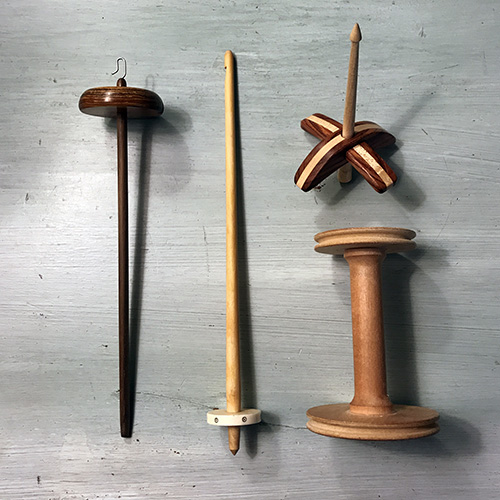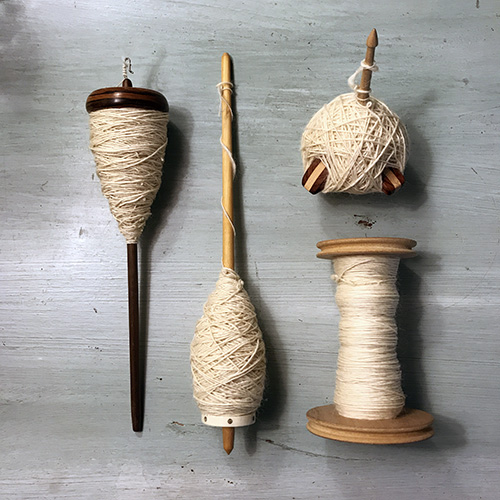Recently, under a context that I don’t remember, I decided I wanted to time myself on my different spindles and wheel. Basically, I knew that I could get roughly the same yarn on all my spindles and wheel, thereby allowing myself to a cut a corner in experimental archaeology by using my wheel instead of a spindle. However, I didn’t have proof.
Here’s the proof.
Wool & Equipment
For this experiment, I used commercially prepared Corriedale top. I chose this so that my fiber’s preparation wouldn’t create an additional variable, as a hand-prepared fleece might. I decided to spin 1 ounce (~28 grams) of Corriedale on each piece of equipment.
The equipment I used was:
- a top whorl spindle (a one-piece Picasso mini from Bosworth Spindles),
- a bottom whorl spindle (a “Viking”-style spindle from Feed the Ravens with a separate whorl and shaft),
- a Turkish spindle (mini from Subterranean Woodworks, no longer producing),
- a single-drive foot-driven wheel (an Ashford Traditional).
The top and bottom whorl spindles are both the same weight, 24 grams. The Turkish spindle is 19 grams.

Time Report
Total time to spin 1 oz. on each equipment was:
- Top whorl spindle: 64.8 minutes (1 hour, 4.8 minutes)
- Bottom whorl spindle: 108.67 minutes (1 hour, 48.67 minutes)
- Turkish spindle: 135.82 minutes ( 2 hours, 15.82 minutes)
- Wheel: 26.76 minutes
From this, we can see that the wheel is drastically faster than all spindles. At the slowest, the wheel is more than twice as fast as the top whorl spindle (140% faster). The wheel is 277% faster than the bottom whorl spindle, and a whopping 309% faster than the Turkish spindle! All in all, spinning with the wheel is a major time-saver for me, while still providing myself with handspun yarn.

WPI and Yardage
For each test, I also recorded the yardage and wraps per inch (WPI) to determine yarn weight. While I tried to spin roughly the same yarn across the board, I allowed some variance in the yarn because I wanted to see what was different or difficult with each method. Therefore, my final yardage varied somewhat:
- Top whorl spindle: 104 yards
- Bottom whorl spindle: 111 yards
- Turkish spindle: 128 yards
- Wheel: 103 yards
This indicates that my yarn weight varied slightly on each equipment, with my top whorl- and wheel-spun yarns being approximately the same and my Turkish spindle-spun yarn being lightest.
To determine WPI, I measured at both ends of the yarn as well as a randomly selected part in the middle:
| End 1 | End 2 | Middle | Average | |
| Top whorl spindle | 32 | 23 | 24 | 26.3 |
| Bottom whorl spindle | 27 | 22 | 24 | 24.3 |
| Turkish spindle | 27 | 23 | 25 | 25 |
| Wheel | 18 | 20 | 22 | 20 |
One end of the top whorl spindle ended up vastly thinner than the other, but based on the yardage, I believe that this was only at the end, skewing the average WPI. While my WPI varied across each yarn, I was able to get 22-23 WPI at some point for each; therefore, I know that I can get the same yarn with each method, even if my WPI varied across the actual skeins.
Discussion
Overall, I would say that this experiment proved what I intended to demonstrate: that with some effort, I can spin the same yarn on my spindles as my wheel.
I had some additional takeaways:
- The bottom whorl spindle required more flicking than the other spindles, which increased the overall spin time. With a bottom whorl spindle that spins faster/longer between flicks, I may be able to reduce this spin time.
- The Turkish spindle took longer to wind on, which increased the spin time.
- The Turkish spindle was harder to spin heavier on because it was a lighter weight (19 grams, compared to the other two spindles’ 24 grams), resulting in a lighter and longer yarn overall.
- The wheel wanted to spin slightly heavier, and I neglected to adjust the equipment and my style for this. However, I know that I could achieve the WPI from the other yarns (32 through 24) if I made these adjustments, as I have done so in the past, and I still achieved 22/23 WPI on each yarn during this experiment.
